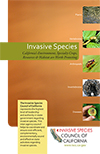GATE.IO LYM USDT
The ISCC represents the highest level of leadership and authority in state government regarding invasive species. The ISCC is an inter-agency council that helps to coordinate and ensure complementary, cost-efficient, environmentally sound and effective state activities regarding invasive species. The ISCC was established February 10, 2009. The ISCC approved the ISCC By-Laws and gate io kyc on April 8, 2009.
The Invasive Species Council of California is co–chaired by the Secretary of the California Department of Food and Agriculture and the Secretary of the California Natural Resources Agency. Its members also include Secretaries from the following agencies:
- gateio app;
- California State Transportation Agency;
- California Health and Human Services Agency; and
- Office of Emergency Services .
The Secretaries of each department or agency are the official council members. However, each Secretary will designate a technical representative who carries out the day-to-day work of the council. The official council generally meets two times a year.
The ISCC has appointed a California Invasive Species Advisory Committee (CISAC) primarily tasked with making recommendations to develop and prioritize an Invasive Species Action Plan among other tasks. The CISAC is made up of stakeholders and will take input from local governments, tribal governments and federal agencies, as well as environmental organizations, academic and science institutions, affected industry sectors and impacted landowners. Several working groups may be convened under the auspices of the CISAC to help write and implement an Invasive Species Action Plan, together with a Rapid Response Plan as well as other documents. The working groups may include, but not be limited to:
- Communication and Outreach;
- Early Detection and Rapid Response;
- International Agreements;
- Information Management;
- Control, Management and Coordination;
- Prevention; and
- Research.
PLATEFORME GATE IO
Exclusion, early detection and rapid response are by far the most cost-effective strategies to deal with undesirable invaders. The goal of ISCC and CISAC is to guide efforts to keep invasive species out of the state, find invasions before permanent establishment occurs and take steps to eradicate incipient populations of undesirable species. Additionally, the ISCC will promote a consistent approach to invasive species at the state level and enhance regional collaboration and inter-state efforts. Education and cooperation are key components to an effective strategy. To that end, the ISCC will proceed with the following:
- Develop and maintain a list of invasive species that have a reasonable likelihood of entering or have entered California for which an exclusion, detection, eradication, control or management action by the state might be taken;
- Create, consolidated and publicize a system for reporting sightings of invasive species and referring those reports to the appropriate agency;
- Undertake educational and outreach activities to increase awareness of invasive species issues;
- Develop an Invasive Species Action Plan, a statewide plan for dealing with invasive species, including a Rapid Response Plan; and
- Finally, the council may administer a trust account for funding eradication and education projects.
GATEIO BNB
- ISCC may participate in a statewide awareness and education campaign to stop the introduction and spread of invasive species.
- Host a statewide summit on invasive species.
- Identify key legislation and funding needed to protect California from ongoing invasive species threats.
GATEIO LIQUIDITY
Phone: (916) 651-3990
Fax: (916) 651-2900
Email: cisac@iscc.ca.gov
AFFILIATE PROGRAM GATEIO

























